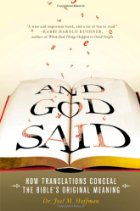 I nice little book, And God Said: How Translations Conceal the Bible’s Orginal Meaning, by Dr Joel M. Hoffman, gives us some valuable and interesting insights into the complexities involved with translating from Hebrew to English. He entertainingly discusses some culturally entrenched mistranslations that we have inherited in most of our Bibles, too.
I nice little book, And God Said: How Translations Conceal the Bible’s Orginal Meaning, by Dr Joel M. Hoffman, gives us some valuable and interesting insights into the complexities involved with translating from Hebrew to English. He entertainingly discusses some culturally entrenched mistranslations that we have inherited in most of our Bibles, too.
I am sure I am not the only one with an interest in Bible study who has been known to struggle to find original meanings of Hebrew words by piecing together data from a number of lexicons and dictionaries. Hoffman has a discussion highlighting three common methods of understanding Hebrew that don’t work very well. I can understand his advice being fit for amateurs but he seems to be saying that even professional translators have also at times fallen into these traps:
Unfortunately, three common methods of understanding Hebrew are rampant among translators, and none of them works very well. The three methods are internal word structure, etymology, and cognate languages. (p.21)
The news is not all bad, though. Hoffman does discuss a fourth method that really does work. But first he addresses the three bad wolves.
Wrong: Internal word structure
Hoffman illustrates the problem here with English language analogies.
The word “patent” by definition means a “non-obvious art”, with “art” being use in its technical sense to embrace science as well what we think of as art. But the key part of the definition is “nonobvious”.
In fact, Section 103 of Title 35 of the U.S. Code, the part of U.S. law that deals with patents, specifically notes that “non-obvious subject matter” is a “condition for patentability.”
He incidentally refers to one wag who managed to patent the simple stick though describing it in a way to hide its obviousness, and I have seen a patent go through for “a circular transportation facilitation device” (the wheel!) — again clever scientific jargon can be used to make something obvious seem quite novel.
Now since the suffix “-ly” usually turns a word into an adverb, one might expect that patently would mean doing something in a non-obvious way. But of course we know the word means the exact opposite!
Again, the word “host” means someone who welcome guests at parties. But “hostile”, once again, has an opposite meaning. If we tried to use the word “host” to understand “hostile”, or vice versa, we would get a completely wrong answer.
Knowing the meaning of “intern” does not help us in any way to establish the meaning of “internal”. Continue reading “3 wrong ways (and 1 right way) to translate Biblical Hebrew”
